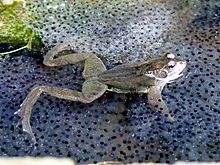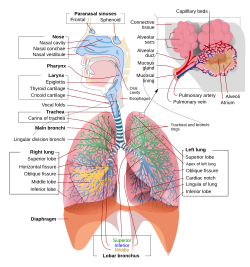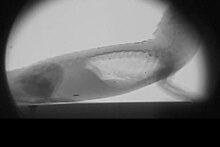The human reproductive system usually involves internal fertilization by sexual intercourse. During this process, the male inserts his erect penis into the female's vagina until he ejaculates semen, which contains sperm. The sperm then travels through the vagina and cervix into the uterus or fallopian tubes for fertilization of the ovum. Upon successful fertilization and implantation, gestation of the fetus then occurs within the female's uterus for approximately nine months, this process is known as pregnancy in humans. Gestation ends with birth, the process of birth is known as labor. Labor consists of the muscles of the uterus contracting, the cervix dilating, and the baby passing out the vagina (the female genital organ). Human's babies and children are nearly helpless and require high levels of parental care for many years. One important type of parental care is the use of the mammary glands in the female breasts to nurse the baby.[1]
The female reproductive system has two functions: The first is to produce egg cells, and the second is to protect and nourish the offspring until birth. The male reproductive system has one function, and it is to produce and deposit sperm. Humans have a high level of sexual differentiation. In addition to differences in nearly every reproductive organ, numerous differences typically occur in secondary sexual characteristics.
The major reproductive organs of the male can be grouped into three categories. The first category is sperm production and storage. Production takes place in the testes which are housed in the temperature regulating scrotum, immature sperm then travel to the epididymis for development and storage. The second category are the ejaculatory fluid producing glands which include the seminal vesicles, prostate, and the vas deferens. The final category are those used for copulation, and deposition of the spermatozoa (sperm) within the male, these include the penis, urethra, vas deferens, and Cowper's gland.
Major secondary sexual characteristics includes: larger, more muscular stature, deepened voice, facial and body hair, broad shoulders, and development of an adam's apple. An important sexual hormone of males is androgen, and particularly testosterone.
The testes release a hormone that controls the development of sperm. This hormone is also responsible for the development of physical characteristics in men such as facial hair and a deep voice.
The vagina meets the outside at the vulva, which also includes the labia, clitoris and urethra; during intercourse this area is lubricated by mucus secreted by the Bartholin's glands. The vagina is attached to the uterus through the cervix, while the uterus is attached to the ovaries via the fallopian tubes. Each ovary contains hundreds of egg cells or ova (singular ovum).
Approximately every 28 days, the pituitary gland releases a hormone that stimulates some of the ova to develop and grow. One ovum is released and it passes through the fallopian tube into the uterus. Hormones produced by the ovaries prepare the uterus to receive the ovum. The lining of the uterus, called the endometrium, and unfertilized ova are shed each cycle through the process of menstruation. If the ovum is fertilized by sperm, it attaches to the endometrium and the fetus develops.
The female reproductive system has two functions: The first is to produce egg cells, and the second is to protect and nourish the offspring until birth. The male reproductive system has one function, and it is to produce and deposit sperm. Humans have a high level of sexual differentiation. In addition to differences in nearly every reproductive organ, numerous differences typically occur in secondary sexual characteristics.
Structure
Male
The male reproductive system is a series of organs located outside of the body and around the pelvis region of a male that contribute towards the reproduction process. The primary direct function of the male reproductive system is to provide the male sperm for fertilization of the ovum.The major reproductive organs of the male can be grouped into three categories. The first category is sperm production and storage. Production takes place in the testes which are housed in the temperature regulating scrotum, immature sperm then travel to the epididymis for development and storage. The second category are the ejaculatory fluid producing glands which include the seminal vesicles, prostate, and the vas deferens. The final category are those used for copulation, and deposition of the spermatozoa (sperm) within the male, these include the penis, urethra, vas deferens, and Cowper's gland.
Major secondary sexual characteristics includes: larger, more muscular stature, deepened voice, facial and body hair, broad shoulders, and development of an adam's apple. An important sexual hormone of males is androgen, and particularly testosterone.
The testes release a hormone that controls the development of sperm. This hormone is also responsible for the development of physical characteristics in men such as facial hair and a deep voice.
Female
The human female reproductive system is a series of organs primarily located inside of the body and around the pelvic region of a female that contribute towards the reproductive process. The human female reproductive system contains three main parts: the vagina, which leads from the vulva, the vaginal opening, to the uterus; the uterus, which holds the developing fetus; and the ovaries, which produce the female's ova. The breasts are involved during the parenting stage of reproduction, but in most classifications they are not considered to be part of the female reproductive system.The vagina meets the outside at the vulva, which also includes the labia, clitoris and urethra; during intercourse this area is lubricated by mucus secreted by the Bartholin's glands. The vagina is attached to the uterus through the cervix, while the uterus is attached to the ovaries via the fallopian tubes. Each ovary contains hundreds of egg cells or ova (singular ovum).
Approximately every 28 days, the pituitary gland releases a hormone that stimulates some of the ova to develop and grow. One ovum is released and it passes through the fallopian tube into the uterus. Hormones produced by the ovaries prepare the uterus to receive the ovum. The lining of the uterus, called the endometrium, and unfertilized ova are shed each cycle through the process of menstruation. If the ovum is fertilized by sperm, it attaches to the endometrium and the fetus develops.
Development of the reproductive system
The development of the reproductive system and urinary systems are closely tied in the development of the human fetus. Despite the differences between the adult male and female reproductive system, there are a number of homologous structures shared between them due to their common origins within the fetus. Both organ systems are derived from the intermediate mesoderm. The three main fetal precursors of the reproductive organs are the Wolffian duct, Müllerian ducts, and the gonad.
Endocrine hormones are a well known and critical controlling factor in the normal differentiation of the reproductive system.[2]
The Wolffian duct forms the epididymis, vas deferens, ductus deferens, ejaculatory duct, and seminal vesicle in the male reproductive system and essentially disappears in the female reproductive system. For the Müllerian Duct this process is reversed as it essentially disappears in the male reproductive system and forms the fallopian tubes, uterus, and vagina in the female system. In both sexes the gonad goes on to form the testes and ovaries, because they are derived from the same undeveloped structure they are considered homologous organs. There are a number of other homologous structures shared between male and female reproductive systems. However, despite the similarity in function of the female fallopian tubes and the male epididymis and vas deferens, they are not homologous but rather analogous structures as they arise from different fetal structures:
In males, this process is known as spermatogenesis and takes place only after puberty in the seminiferous tubules of the testes. The immature spermatozoon or sperm are then sent to the epididymis where they gain a tail and motility. Each of the original diploid germs cells or primary spermatocytes forms four functional gametes which is each forever young. The production and survival of sperms require a temperature that is lower than the normal core body temperature. Since the scrotum, where the testes is present, is situated outside the body cavity, it provides a temperature about 3 °C below normal body temperature.
In females, gametogenesis is known as oogenesis which occurs in the ovarian follicles of the ovaries. This process does not produce mature ovum until puberty. In contrast with males, each of the original diploid germ cells or primary oocytes will form only one mature ovum, and three polar bodies which are not capable of fertilization It has long been understood that in females, unlike males, all of the primary oocytes ever found in a female will be created prior to birth, and that the final stages of ova production will then not resume until puberty.[3] However, recent scientific data has challenged that hypothesis.[4] This new data indicates that in at least some species of mammal oocytes continue to be replenished in females well after birth.[5]
The Wolffian duct forms the epididymis, vas deferens, ductus deferens, ejaculatory duct, and seminal vesicle in the male reproductive system and essentially disappears in the female reproductive system. For the Müllerian Duct this process is reversed as it essentially disappears in the male reproductive system and forms the fallopian tubes, uterus, and vagina in the female system. In both sexes the gonad goes on to form the testes and ovaries, because they are derived from the same undeveloped structure they are considered homologous organs. There are a number of other homologous structures shared between male and female reproductive systems. However, despite the similarity in function of the female fallopian tubes and the male epididymis and vas deferens, they are not homologous but rather analogous structures as they arise from different fetal structures:
| Male organ | Female organ | Shared function |
|---|---|---|
| Cowper's gland | Bartholin's glands | Lubrication secretions |
| Penis | Clitoris | Erectile tissue and sensation |
| Testes | Ovary | Gamete production |
| Prostate gland | Skene's gland | Ejaculatory fluid and sensation |
Process
Production of gametes
The production of gametes takes place within the gonads through a process known as gametogenesis. Gametogenesis occurs when certain types of germ cells undergo meiosis to split the normal diploid number of chromosome(n=46) into haploids cells containing only 23 chromosomes.[3]In males, this process is known as spermatogenesis and takes place only after puberty in the seminiferous tubules of the testes. The immature spermatozoon or sperm are then sent to the epididymis where they gain a tail and motility. Each of the original diploid germs cells or primary spermatocytes forms four functional gametes which is each forever young. The production and survival of sperms require a temperature that is lower than the normal core body temperature. Since the scrotum, where the testes is present, is situated outside the body cavity, it provides a temperature about 3 °C below normal body temperature.
In females, gametogenesis is known as oogenesis which occurs in the ovarian follicles of the ovaries. This process does not produce mature ovum until puberty. In contrast with males, each of the original diploid germ cells or primary oocytes will form only one mature ovum, and three polar bodies which are not capable of fertilization It has long been understood that in females, unlike males, all of the primary oocytes ever found in a female will be created prior to birth, and that the final stages of ova production will then not resume until puberty.[3] However, recent scientific data has challenged that hypothesis.[4] This new data indicates that in at least some species of mammal oocytes continue to be replenished in females well after birth.[5]





